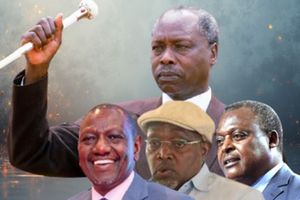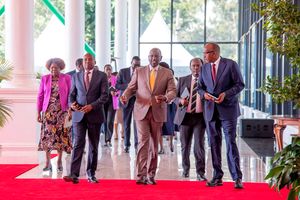Premium
Will theatre survive Covid-19? How Kenya’s art scene is fairing

Bryan Ngatia, aka Ngartia, (right) and fellow performers during a past production of Too Early For Birds.
PHOTO | COURTESY
What you need to know:
- Initiatives that created more opportunities as well as much-needed exposure for artists have also been put on hold as a result of the coronavirus.
- This has affected both film and the performing arts in different ways.
- As cinemas also remain closed, film screenings have been limited either to digital festivals or shared watch parties using extensions such as Netflix Party.
“Finally!”
This was the first word that popped into Bryan Ngatia’s mind after the government announced the first diagnosis of Covid-19 in the country on March 13.
Bryan, who goes by his stage name, Ngartia, is an actor and writer, a member of Story Zetu Limited, the company that produces Too Early For Birds, a series of theatre shows that stages diverse stories from Kenyan history.
At the time of the announcement, their next show was scheduled a month later, in April. The team had written and edited the scripts. They were ready. Soon after the announcement, the show was cancelled to abide by the government’s directive regarding social distancing to curb the spread of the virus.
“Finally!” The word that popped to mind, had nothing to do with jubilation, it was more a sigh of relief as the reality of the pandemic began to unfold for the production and the arts industry at large.
“We knew that the first confirmed case would mean facing difficult decisions. I’ve no problem with hard decisions. The uncertainty was draining, though. And because I’m in a team of chronically optimistic people, we were still hoping for the best. It is the hope that kills you, though,” he says.
Social gatherings sustain the performing arts. Before Covid-19, strangers would queue in winding lines to buy tickets for shows, then commune in a dark room to watch either a film or theatrical performance. Now, with audiences setting up schedules to support their favourite artists on social media as the world continues to observe social distancing, the theatre finds itself emptier than it has ever been, its future left to speculation.
Today, the Kenya National Theatre on Harry Thuku Road, Nairobi, is silent, save for the wind that rustles the leaves of the large mugumo tree at the centre of the courtyard. At the door, a guard checks my temperature using a gun, then points me to a bottle of hand sanitiser at the reception. The doors are open, and on the stage is a DJ filming a “Plus254 Live” set as part of a stream broadcast on Homeboyz TV.
The same venue hosted Cabinet Secretary Amina Mohammed just days before when she announced the launch of the government stimulus programme for the arts sector, an amount of Sh100 million, which is to be disbursed to artists who create content during this period to help the general public “alleviate daily stresses”.
The CS asked the media fraternity to support the creative economy by implementing the 60 per cent quota for local content. She noted that Covid-19 had bankrupted the artistic ecosystem and left many who rely on their craft unable to meet their basic needs.
Even with the three-month-long “Together At Home” campaign off the ground, conversations with those directly affected by this major shift reveal that developments in the sector within the past five years had forced them to reimagine themselves in it as they rolled with the tide.
“There is a whole engagement with the digital space that needed a rethink, but also with major shifts in where financing for the creative sector comes from, and a big shift in how revenues are achieved in the space,” explained Sheba Hirst, owner of Rainmaker Limited, a production company responsible for shows such as Tinga Tinga Tales and Live at the Elephant.
“While we had to put on hold plans for shooting videos, new performance models, and writing workshops that we had scheduled, it actually allowed us the opportunity to really think through this new era,” she added.
As the Kenya government gradually eases movement restrictions within Nairobi County, restaurants and bars have redesigned their spaces to accommodate fewer customers in keeping with government regulations to curb the spread of the coronavirus.
Questions on how such regulations will change the consumption of the performing arts remain unanswered. For now, Too Early For Birds resorted to releasing written media on Medium, as the Poetry After Lunch sessions regularly hosted at the Kenya National Theatre now stream their shows on Facebook Live.
The answers to these questions may, however, lie in how other countries coped with similar pandemics. In South Korea, where theatre shows maintained a capacity above 90 per cent amid the coronavirus pandemic, interventions such as temperature checks, contact tracing and the installation of disinfection showers allowed the theatres to stay open.
“We expect vestigial relics of this period to stick around, such as sanitisers and masks. Those have to go into our new budgets. We expect people to be uncomfortable in confined spaces with strangers,” Ngartia says.
The government’s affirmation of the position of art in society during this period could, however, inspire a revolution in the sector.
“People might be hungry for social interaction after all the solitude. We now have time to steadily increase our audience without the pressures of staging shows. More people who were stuck in offices are now exploring their artistic sides. We will definitely have a bigger talent pool to tap into. There are financial bailouts coming from diverse angles, including our audiences,” he added.
Ms Hirst agrees. “I also think most of us will have a deeper appreciation of live events with live audiences. As social animals, we have a need to experience our cultural rituals and performances in communion with one another, from gathering for worship to watching plays, films, and dancing at live concerts. There is an expression of humanity that needs the solidarity of physically experiencing things together.”
What about the production of these shows? Is a socially-distant stage presentation to be expected? Speaking to Alacoque Ntome, a technical director at the Kenya National Theatre, the shift on stage began long before the pandemic.
“Even before Covid-19, a lot of producers were downsizing their casts due to the costs of production,” he said. Rehearsal and theatre cost more than most producers could bear, was hurting them and the talent that relied on their art for their daily bread.
“Some of the more important lessons for us to take away from this are about looking closer at the mechanisms that are supposed to take care of and cushion practitioners in times of crisis — Covid-19 or otherwise,” Ms Hirst affirms.
“Performers really need to examine whether they are being adequately compensated for their labour and whether they have sufficient safety nets to their earnings. This has to be that rallying call for standardising practice, including fair pay across the sector. Especially from the point of view of performers, but also for creating far more financially secure production outfits that can withstand economic downturns and revenue-impacting crises. It is also a critical moment for demanding better services, representation, and subsidy for the sector from the state.”
The transition to digital media has served as an adequate cushion for the performing arts in other countries. While physical theatres may require bailouts to survive, a lot of their media can currently be viewed for free, as is the case with the National Theatre in the United Kingdom. In early May, the theatre also announced that the artists would be compensated for the work currently being streamed worldwide.
“It’s interesting watching everyone finally understand what we have been preaching for the last decade. The digital space is where you should be pitching camp,” Ngartia says.
“Something we had already outgrown has also been eliminated. The audience now has a more direct relationship with the artist. They can send them money straight to their accounts,” he added.
Initiatives that created more opportunities as well as much-needed exposure for artists have also been put on hold as a result of the coronavirus. This has affected both film and the performing arts in different ways. As cinemas also remain closed, film screenings have been limited either to digital festivals or shared watch parties using extensions such as Netflix Party.
The Nairobi Film Festival, an annual platform for the showcasing of choice films within the Kenyan sphere, is just one of these initiatives.
“Despite a significant amount of pressure to have a digital festival, we have been reluctant to go that direction because everything in our philosophy has been predicated on convening audiences for physical screening events — to recreate the magic I mentioned before of a shared emotional moment,” Ms Hirst explains, in her capacity as a co-founder of the event.
The new regulations could also see the return of the drive-in cinema and other outdoor screenings, making use of parking lots and public spaces like Uhuru Park with adequate space for social distancing.
“What we’re possibly able to offer is curation and possibly collaborating with existing digital distributors to present a particular curation of their existing material or helping to guide their acquisitions. We’re also thinking about spaces like the old drive-in cinemas, which have gotten a new lease on life in other parts of the world and outdoor cinema in open fields — we’ve already experimented with this — with community screenings in Kibra last year,” she adds.
The current situation could also allow for an upheaval of the arts sector, a sentiment shared by the ministry as well the artist community. In her address, CS Amina Mohammed took note of a lack of data on the number of artists in the country, which would make planning for government interventions difficult to start and implement. An independent survey by creative financier Heva Fund reveals that about 61 per cent of the 510 respondents involved in their Covid-19 resilience survey are members of any organisation related to their line of work.
This scarcity was attributed to, among other reasons, a wariness of these organisations, as well as the inability to pay the registration fees. In response to this, the CS spoke of a survey being carried out to address the issue of the scarcity of data, in addition to waiving registration fees to these organisations.
It’s about time. “Look, I’m happy that the stimulus package exists and that the challenges of the creative sector are getting a more public airing, and also that an important (though sometimes painful) discourse on what value is placed on creative production in our society and within our governance structure,” Ms Hirst said.
“I also appreciate the introspection the stimulus package has ignited. Sure, it’s not enough to get a whole sector back on its feet; maybe the parameters for participation are too restrictive and don’t really capture how the sector creates work. Yes, the mechanisms for fair access are not as well established or trusted as they could be. But we seem to finally be asking the right questions.”
Ngartia thinks otherwise. “We will not be fooled. That ministry has never really cared for artists. We have not forgotten how horribly they have treated our athletes in the last few years. This situation has few congratulations opportunities. We need a Minister of Solutions for once,” he said.
“I’ll say it once more so there can be no doubt: our government will fail artists. The biggest impact will be artists realising that nothing has changed. We are still on our own. The only people who have our backs are our fellow artists and our audience. We need to prioritise that.”
As the time for promises and words of affirmation in the industry grinds to a halt, the future of theatre and the arts as a whole lies in community. “I expect there to be more generosity. This is the time to share data, strategies, learnings, and resources, among ourselves,” says Ngartia. “People in other professions also need to open their eyes to the opportunities in the art sector. We’re in need of professional marketers, lawyers, accountants and financial analysts. There is a whole scene that could be a veritable industry if you all showed up and took these burdens off our shoulders and allowed us to do what we do best: art.”
Ms Hirst agrees. “I think there will be better and clearer sector-led representation of the arts to and within government, stronger industry-led mechanisms that advocate and lobby of the interest of the sector, better crisis-proof business models that will serve the sector, and improved social and economic cushioning for individual practitioners to help them overcome distress situations such as these.”





